| Document-12. |

|
The Eyes of Fighter Command
During the great war of 1914-1918, the means of enemy detection was simply by the see and hear system. Aircraft would be instructed to go on routine observation patrols to seek out enemy artillery and aircraft formations. By the end of the war, it was realised that with the advent of faster aircraft a more sophisticated system of detection would be required. By 1920, Britain was experimenting with "sound locators". These relied on the echo of aircraft noise bouncing out of curved concrete walls, or huge circular discs facing the sea. Later, these walls, scientifically termed "Acoustical Mirrors" were increased in size to approximate 200 feet in length.
Immediately problems started to occur. Not only did they manage to pick up aircraft noise, but the sound of the sea, the noise of calling sea birds and noise of passing ships could all be picked up by the
Acoustical Mirrors, providing they were within the 'mirrors' six mile range.
But unknown to the Air Ministry, a scientist, Dr Robert Watson-Watt, of the National Physical Laboratory had submitted a report in 1932 that during experiments he had found that aircraft had interfered with radio signals and had radiated the signal back to his base. In 1922, both Watson-Watt and a Dr Appleton had taken possession of two American cathode ray tubes. Dr Appleton was experimenting with the height of the ionosphere while Watson-Watt was more concerned with the transmission of radio waves. Basically, it is on these experiments conducted by the two scientists that gave birth to what was to become universally known as radar. This was also to become "The Eyes of Fighter Command". The "Ears of Fighter Command" were in the form of "Ultra", because the British had managed to acquire a German Enigma machine and after decoding their messages, listened in to German plans and orders that were being sent from one HQ to another. With RDF, they could see Luftwaffe formations forming up over the French coast, they could see the size and direction of the enemy flight path and could plot it all the way to the English coast. With Ultra, they could intercept coded messages that told them of orders from the German High Command to its command leaders, or any movements either by the German navy, air force or the army. Britain had a very clear picture of just about everything that was taking place within the German military machine. Something that the German military machine had failed to implement on a comprehensive basis in their strategy of attack.
THE EYES OF FIGHTER COMMAND
The experiments by Kühnold were based on experiments conducted by a Dr. Hans Hollmann, Hans-Karl von Willisen and a Guenther Erbsloeh. The three formed a partnership and formed the GEMA Company which continued the work of fellow countryman Hulsmeyer who had been granted a British Patent No.13170 to further his work after he had built and demonstrated the first form of radar back on 1904. Towards the end of 1934, the GEMA Company had built the first radar transmitter that could detect a ship 10 kilometres away. By 1935, using a magnetron, an experiment detected a ship at eight kilometres distant, but it was believed that the frequency was unstable. Reverting back to tubes, further experiments demonstrated that an aircraft at 500 metres and at 28 kilometres away could be reliably be detected. So, by the end of 1935 they had built the first successful radar unit. Two types of radar were built, one using a frequency of 1.8-2.0 metres to be used in aircraft detection and was to become known as Freya, while the other using a frequency of 80 centimetres to be used by the navy and would become known as Seetakt.
Many improvements were made to Freya. In 1936, the Telefunken Company introduced a new radar that would compliment Freya called Wuerzbug. The idea was that Freya who could only detect and track enemy aircraft, and Wuerzbug which could determine the height and range of detected aircraft, and by combining both units an efficient form of radar was available.
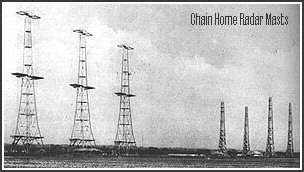
By 1939, Germany was far ahead than Britain as far as any form of radio detection was concerned. But for some reason,
after this they fell hopelessly behind, preferring to concentrate on the radar for the navy but not placing radar high on the priority list as far as
airborne detection was concerned. In late 1934, a government
committee under Sir Henry Tizzard asked Robert Watson-Watt, a scientist
at the National Physical Laboratory if there was any future in a 'death
ray' that would destroy an enemy aircraft. In 1935, Watson-Watt
came back to them pointing out that he had identified three very important
areas that should be further investigated. The use of radiated radio waves
in the detection of aircraft, the possibility of using radio telecommunications
between operators on the ground with any defending aircraft that would
direct them to enemy aircraft that had been located and some form of coded
signal that could be sent from friendly aircraft so as to identify them
as being friendly. He advised against looking into the possibilities of
a 'death ray'.
The committee went into discussion, arguments
for and against, and whether Watson-Watts idea was a feasible possibility.
Soon they agreed, and Henry Tizzard stated that the committee had decided
to give every support to Watson-Watt and requested him to continue with
his research. Experiments in radio detection was originally started at
Orfordness on the east coast, but because of expansion and the possibility
of tests based on the research of Watson-Watt, additional land was acquired
at Bawdsey Manor near Felixstowe. By 1936, Hugh Dowding had met and conferred
with Watson-Watt who had pointed out to the Fighter Command chief of the
possibilities and advantages of radio detection in the event of war. Dowding
was impressed with the scientist's views and gave it his full support.
When Henry Tizzard had given the 'green light' to Watson-Watt, the government
had proposed expenditure on the construction of four radio detection Stations
(In these early years the name of radar had not yet been given to the
system. The name of Radio Detection Finding, otherwise known as RDF was
used). This was further extended to include the construction of twenty
Stations around the east and southern coasts by August 1937.
Most of the scientists working on the project
were civilians, the first Royal Air Force specialist to become involved
was Squadron Leader Raymond Hart in July 1936. Early results of test carried
out in April 1937 were a failure, said to be confusing and disappointing
and Dowding stated that they were unsatisfactory for use in Operation Rooms.
Raymond Hart studied these reports, and came up with the following opinion:
Further developments
were then carried out using the principle of Robert Watson-Watt, and a
chain of twenty stations were constructed. Bawdsey was still the main station
and also had a filter room where sightings and detection could be sorted
out. The range that these stations could be expected to detect aircraft
were: at 83 miles (132 Km) 13,000 feet (3.939m); 50 miles (80 Km) 5,000
feet (1,515m); 35 miles (56 Km) 2,000 feet (606m); 25 miles (40 Km) 1,000
feet (303m). It was recommended that the stations be built at twenty mile
intervals, with every second transmitting station include a receiver also.
The masts of these stations should be no less than 50 feet (15m) above
sea level and should be constructed with a minimum of 200 feet (60m) in
height.
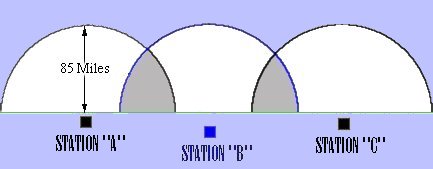
The
graph on the left, although not to scale will give you an idea how the
area covered by each station would create an overlap. If any enemy aircraft
fell into the shaded area, then two stations would have been able to detect
its presence. With Station "A" and Station "C" being transmitting stations
and Station "B" being a transmitter receiver station, all outward signals
would be re-pulsed back on detection of an aircraft and the transmitter-
receiving station would pick up the signal. This system, although it was
not on the earliest of equipment, could also detect the height of any detected
aircraft. This system was called Chain Home, or CH as it became known.
Improvements were constantly being made, and by 1939, the radar range had
been increased to 120 miles, it worked successfully on a frequency of 22
to 30 MHz, the towers had been increased to 350 feet for transmitting and
250 feet for the receivers.
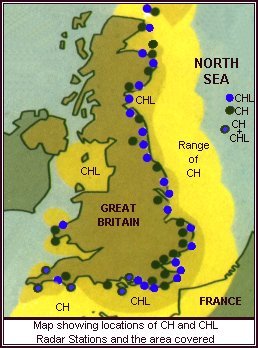
Even
before 1939, Dowding had great hopes for radar as it became known by 1939.
It would be the "eyes" of Fighter Command, enemy aircraft could be seen
approaching and it was now possible to be able to keep track of them, even
if they had decided to alter course across the Channel, Fighter Command
would be advised of this within seconds. By September 1939, arrangements
were made to relocate the Filter Room at Bawdsey to Bentley Priory. The
task was given to Squadron Leader Raymond Hart, who had to change many
of the fittings in the room and also design a new layout complete with
larger plotting board and the installation of a telecommunications system.
But Chain Home (CH), did have one big disadvantage, detection of aircraft
below 5,000 feet was unreliable.
For this purpose, the more complicated
Chain Home Low (CHL) was installed. Using a frequency of 200 MHz and a
power output of only 150 kilowatt's it did not have a range of any distance,
only about 50 miles (80 Km) and could only read straight ahead. As well
as stationary stations of CHL, there were also mobile units situated on
vehicles and these became known as "convoy". Both versions of CHL had rotating
aerials and were a much more precise direction finding than the main CH
sets. The Chain Home Low (CHL) as the name would suggest, was primarily
for the low-level detection of aircraft and had first seen service at Fifeness
in Scotland and the credit for its inception goes to Sir John Cockcroft.
Where the CH system relied on a wide 'floodlight' type of beam, the CHL
was based on a narrow rotating beam that circulated much in the fashion
as a 'lighthouse' light beam. The system was easily constructed and as
mentioned could even be built as a mobile unit. It did not have to have
the massive masts, or the number of masts that the CH required. But even
though the narrow beam could not detect aircraft at any great height, it
facilitated the gap between the lower edge of the CH beam and the surface
of the sea allowing the system to detect aircraft that may be crossing
the Channel at extremely low levels.
The ironical part
about radar, was
that German observation aircraft had picked up a sighting on these masts,
and even the Graf Zeppelin flew up the east coast of Britain. The radioed
back to Germany that they were off the Yorkshire coast and that these masts
could still be seen, (Britain was actually tracking them and they were
actually south and over the town of Hull ) Squadron Leader Walter Pretty
(Later Air Vice Marshal) stated that he was really keen to radio back to
the German airship that they should take a lesson in geography, but in
doing so it would be informing the Germans that they were under surveillance.
But the Germans were under the impression that the masts were used in the
detection of shipping and paid no further attention to them until they
really came to know what they really were.
Between
the transmitting and receiving masts would be the "receiver hut", here
sitting at desks and constantly watching the cathode ray screen in front
of them would be the operators, quite often trained women who would constantly
watch these screens day in, day out. As soon as a "blip" was seen, and
this can be similar to the diagram opposite. The first tall "blip" would
be the signal being sent from the transmitter, if there were no aircraft
out there, then all the operator would see would be a constant wavy line.
If the pulse sent out hit something like an aircraft, then the pulse would
be bounced back and picked up by the receiver towers and would show up
on the screen as a second "blip", the further away the aircraft, the longer
it would take the pulse to return therefore the second "blip" would be
further along the scale. This scale underneath the pulse waves is shown
in miles. If the second "blip" is shown above 60 as in the diagram, then
that will tell the operator that the radar has picked up something sixty
miles away.
The radar defences that were built around
Britain by 1939, were undoubtedly based on the scientific knowledge of
the scientists, Watson-Watt in particular, the government and Fighter Command
(Dowding) who made the final decisions as to whether the system was acceptable
to the Operation Rooms or not, if they weren't, then the system would have
to be changed so that it would comply with the standards set by Hugh Dowding
in particular. Some may say that Britain's radar at the time was nothing
but a stroke of genius, others would have termed it as being a rather system,
but one that worked. But what made it a workable system was the interpretation
of the information that was received, the way that radar along with a visual
sighting system, the way that friendly and hostile aircraft could be segregated
and the sorting out done by the Filter Rooms made the whole system of being
able to "see" the enemy such a successful system.
That was the "Eyes" of the system, all that remained now was to be able to transmit this information to the group and sector controllers so that the defences of Britain could be placed into action.
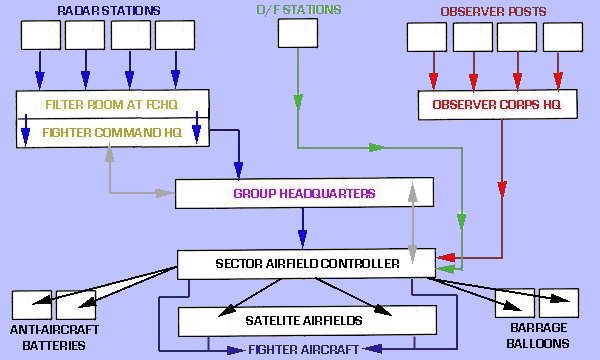
Looking at the diagram above it is possible to see just how the intricate system of detection, reporting and the placing of defence units into action by the combined use of radar and observation.
The "Radar Stations" would be the first to detect any enemy activity. With signals being bounced back and converting this to information of a CRT usually operated by one of the many WAAFs. Here she could get a fairly accurate picture of enemy formations forming up across the Channel. The CRT would tell the operator of enemy height, position and distance and approximate strength. It would also be possible for other radar stations in the area to pick up the same information. As soon as this information has been received it is passed directly to the "Filter Room" at Fighter Command Headquarters. The reason that this information is not sent direct to headquarters is that experienced and skilled personnel in the Filter Room can compare the accuracy of earlier and other plots with current ones that had been detected and also to separate the enemy aircraft from any friendly ones. Once any plot is then confirmed as being accurate is then passed through to the Operations Room at "Fighter Command Headquarters" where markers indicating raid number, position, height, strength and status are moved into position on a huge map table of the British Isles by operators using long sticks called rakes. Wherever a plot has been confirmed it is always known as a raid. Each of these markers was colour coded to the colour coded clock that hung above the table. This way, the controllers could tell just how old each of the plots, or raids were. Depending as to the location of the "Raid", the information is sent at once to the "Group Headquarters" which would be responsible for the area where the raid has been detected. Like the map table at Command HQ, Group HQ has a similar map table, but showing only the area that it is responsible for. Information from Command HQ would inform the Group the details of any incoming raid and its raid number and markers on the map table will indicate the exact position. Like the map table at Command HQ different colour coding on the markers indicate how old the plot is. Where Command HQ only had to notify any of the Group HQs, a little more thought had go be given to the decisions that would be made by the "Group Controller". Reports coming in from the "Direction Finding Station" come in later than the first detections made by the radar stations, and here Group HQ could precisely determine the location of any friendly aircraft or squadron that may be airborne. The Group Controller had now to determine is method of defence. As each group is divided into sectors, 11 Group had six of them with each one of them having a letter to distinguish one from another, Sector A, Sector B, C, D, E and Z. Depending where the raid was coming in from and the direction it was taking, depended as to which "Sector Controller" he would call. Once decided, the same information that he had received from Command HQ would be passed on to the "Sector Airfield Controller".
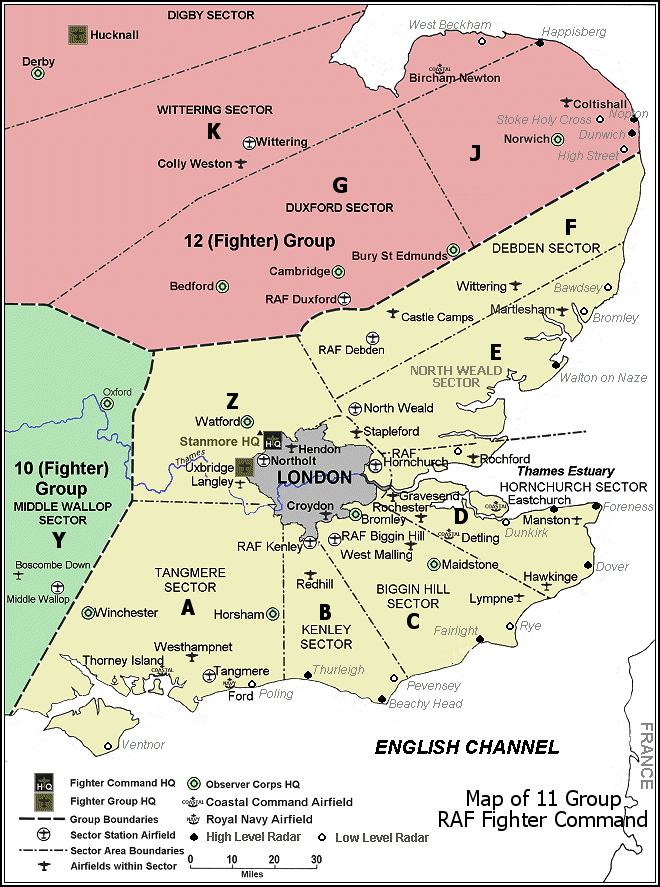 MAP SHOWING THE SECTORS OF FIGHTER COMMAND 11 GROUP It would not be long after receiving this information on the incoming raid, the Sector Controller may have received the latest reports from the "Observer Corps HQ". Sometimes this information was not available until he had already despatched his squadrons, so the information would have to have been sent over the R/T to the Squadrons Flight Leader. The role of the Observer Corps was extremely important because the radar could only see out to sea, and once the enemy formations had crossed the coast the radar system would lose track of them. The Observer Corps would use their sextant like apparatus and could then give a more accurate description as to strength, height and direction and with a comprehensive network of Observer Corps posts inland it was possible to keep track of the formations. Information gathered by the Observer Corps was sent directly to the Sector HQ and each station commander would then pass updated information to his squadron leaders in combat. The role of the Sector Controller was a hectic one once the initial report had been received from Group HQ. Which squadrons to despatch, how many should he scramble, he must keep some in reserve. He would also have some squadrons at his satellite stations or forward airfields. Also, with a bit of luck, Group HQ may also have sent the information to an adjoining Sector Controller, which if this was the case both Sector Controllers would have been notified of this. He also has to decide if he will scramble Hurricanes, Spitfires or even both as it was usual practice that Hurricanes attack the bombers while the Spitfires attack the fighter escorts. On top of this, it is the job of the Sector Controller to then inform the "Anti-Aircraft Batteries" the "Barrage Balloon Squadrons" and the "General Air Raid Warning Alert" to any of the areas that may be affected by the incoming raid. It may seen complicated and a time consuming process, but from the time that it took from when the radar stations first detected the incoming raid, to when the Sector Controller scrambled his squadrons, was no more than ten minutes. It took the fighters a far longer time to reach the desired position and height than it did for the whole enemy detection process to be completed. The Battle of Britain - 1940
website © Battle of Britain Historical Society
2007
|